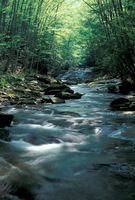
The Seneca Trail was a major thoroughfare during the time the Iroquois Confederation was consolidating its power in eastern North America. The trail was named for the Senecas, one of the Six Nations making up the great Indian empire. The Seneca Trail traversed many counties of present West Virginia, generally in a north-south direction, with some of its most recognizable sections in Tucker, Randolph, and Pendleton counties.
This old path started in western New York near Niagara Falls and extended south through western Pennsylvania by way of the Allegheny and Youghiogheny rivers into western Maryland. From the area of current Oakland, Maryland, the trail entered present Tucker County by way of Horseshoe Run northeast of St. George, crossed the Shavers Fork of Cheat River, and continued south up the Left Fork of Clover Run. It then crossed Pheasant Mountain into Randolph County and followed Leading Creek south to the Tygart Valley River. After passing the vicinity of present Elkins, the trail followed the course of the Tygart Valley River to its headwaters and crossed into what is now Pocahontas County. It continued by way of Edray, Indian Draft Run, and Marlinton, winding its way through Pocahontas County in the vicinity of Hillsboro and Droop Mountain to the Greenbrier River near the Pocahontas-Greenbrier county line. The trail then followed Anthony Creek to White Sulphur Springs and followed the Greenbrier River to the New River and Bluestone River, exiting West Virginia a few miles west of Bluefield, as it continued southward to the Carolinas and Georgia. The trail, in general, follows the route of present U.S. 219 through West Virginia.
Branches of the Seneca Trail radiated in many directions. One of the most important began near Elkins and crossed the four forks of Cheat River to Harman and, by way of Horsecamp Run, crested the mountain to descend by Seneca Creek to its mouth near Seneca Rocks. Some historians refer to this branch as the Shawnee Trail, since that band of Indians used the trail when raiding settlements in the South Branch Valley from the west. Modern U.S. 33 follows much of this branch.
This Article was written by Donald L. Rice
Last Revised on December 10, 2020
Related Articles
Sources
Fansler, Homer Floyd. History of Tucker County. Parsons: McClain, 1962.
Cobb, William H. Indian Trails, Frontier Forts, Revolutionary Soldiers and Pioneers of Randolph County. Elkins: 1923.
Maxwell, Hu. The Seneca Indian Trail. Magazine of History & Biography, (1954).
Cite This Article
Rice, Donald L. "The Seneca Trail." e-WV: The West Virginia Encyclopedia. 10 December 2020. Web. 21 October 2024.



Comments?
There aren't any comments for this article yet.
Click here to read and contribute to the discussion →